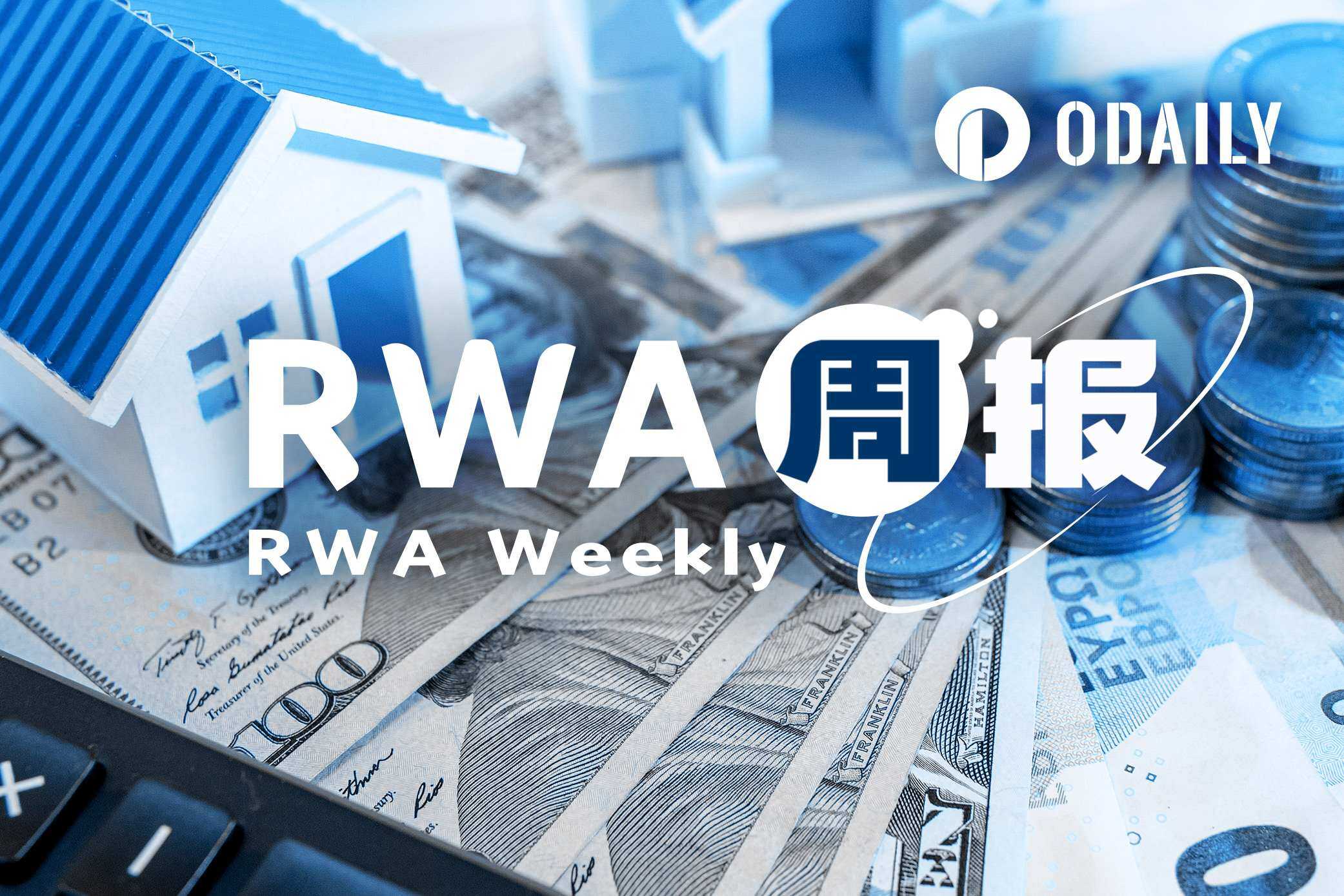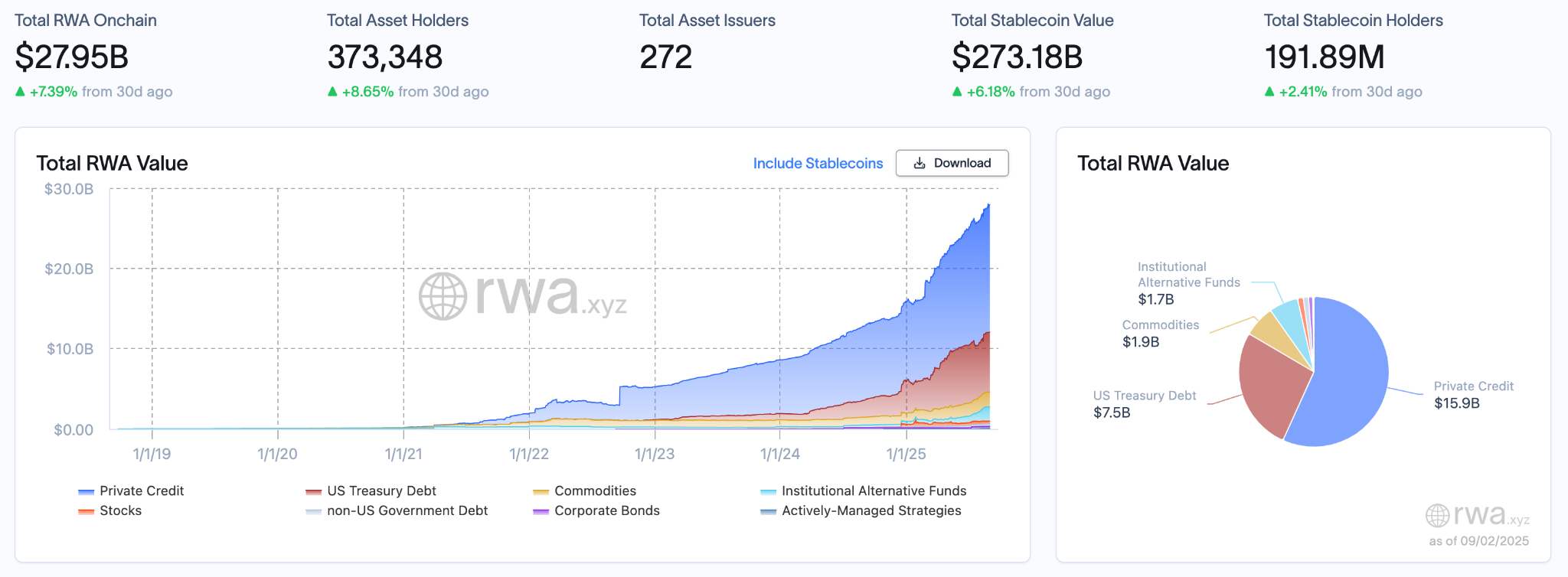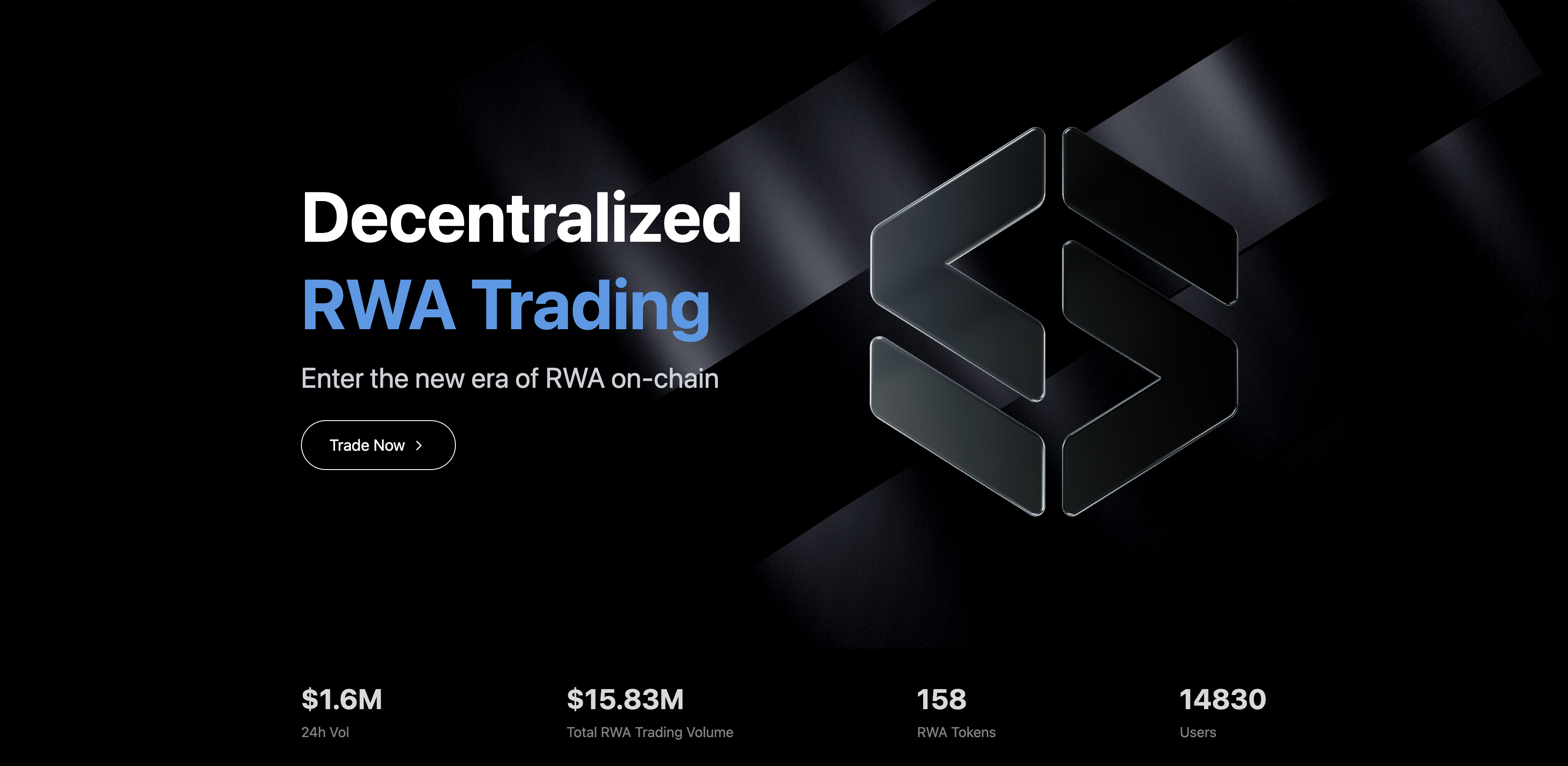Original | Odaily Planet Daily (@OdailyChina)
Author | Ethan (@ethanzhangweb3)_

RWA Market Performance
As of September 2, 2025, the total on-chain value of RWA is $27.95 billion, an increase of $1.45 billion from $26.50 billion on August 26, with a weekly growth rate of 5.47%, marking the largest single-week increase in nearly a month. The number of on-chain asset holders rose from 367,619 to 373,348, with a weekly increase of 5,729 people, a growth rate of 1.56%. The number of asset issuers slightly increased from 271 to 272, maintaining stable growth. In terms of stablecoins, the total value rose from $268.43 billion to $273.18 billion, an increase of $4.75 billion, with a weekly growth rate of 1.77%; the number of holders increased from 190.09 million to 191.89 million, an increase of 1.8 million people, a growth rate of 0.95%.
From the asset structure perspective, private credit rose from $15.5 billion to $15.9 billion, with a weekly growth rate of 2.58%, continuing to hold a core asset position. U.S. Treasury bonds slightly increased from $7.4 billion to $7.5 billion, with a growth rate of 1.35%, maintaining positive growth for three consecutive weeks. Commodity assets increased by $100 million to $1.9 billion, showing stable performance. Institutional alternative funds surged from $1 billion to $1.7 billion, with a weekly growth of 70%, becoming the most prominent highlight in this week's market structure, indicating a significant increase in institutional willingness to allocate to non-standard assets.
Trends (Compared to Last Week)
As of early September, the RWA market is showing a trend of "accelerated expansion + structural layering." The total market value and stablecoin scale are rising in tandem, with users and issuers continuously increasing, enhancing ecological resilience and activity. From the asset side, credit and U.S. Treasury bonds remain core supports, but the dramatic growth of institutional alternative funds has become the biggest highlight this week, reflecting a dual signal of rising market risk appetite and accelerated capital rotation. In the short term, the RWA market is expected to continue expanding within a high range, with private credit and U.S. Treasury bonds forming a solid foundation, while alternative funds may become the core variable driving further increases in market value.

Key Events Review
Hong Kong Stablecoin Regulations Receive 77 Applications in First Month
The "Stablecoin Regulations" came into effect on August 1, and the Hong Kong Monetary Authority previously encouraged institutions interested in applying for a stablecoin issuer license in Hong Kong to contact the authority by August 31. A spokesperson for the Hong Kong Monetary Authority announced on September 1 that a total of 77 applications were received in August, involving institutions from banks, technology companies, securities/asset management/investment firms, e-commerce, payment institutions, and startups/Web 3 companies. The spokesperson reiterated that only a few stablecoin licenses would be granted in the initial phase of the regulations.
Digital asset custody and wallet infrastructure provider Cobo announced that its application for a next-generation RWA tokenization, custody, and settlement infrastructure project supported by JD Technology has been successfully selected for the Hong Kong Cyberport "Blockchain and Digital Asset Pilot Subsidy Program."
The project focuses on income-generating assets and aims to create an integrated infrastructure covering token issuance, compliant custody, and fund settlement, serving institutional scenarios with real business needs to enhance asset liquidity, transparency, and operational efficiency, and to assist Hong Kong institutions in conducting RWA pilots and commercial implementation.
The "Blockchain and Digital Asset Pilot Subsidy Program" aims to promote the development and testing of high-impact blockchain and Web 3 applications, encouraging companies to explore innovative commercialization paths through pilot projects. Approved projects can receive funding in two phases for initiating and completing pilot tests.
CZ: The Next Major Breakthrough in Crypto May Come from AI, RWA, and Stablecoins in Blockchain
During a fireside chat at BNB Day in Tokyo Station, CZ stated that BNB Chain is primarily community-driven. He does not do much himself, mainly tweeting and encouraging people to BUILD. He revealed that he holds a large amount of BNB, with a significant portion of his wealth tied to it.
If he were 20 years younger, CZ said he would choose to develop AI trading agents and privacy-focused perpetual DEXs, predicting that DEX trading volume will surpass CEX in the future, and that DeFi is the future. He believes RWA is still in its early stages but has high potential. He hopes Japan will have a dedicated BNB Chain team, as Japan is very suitable for technological development and has a good business culture. He looks forward to seeing more AI + robotics projects appear on BNB Chain.
CZ believes that the Digital Asset Treasury (DAT) makes cryptocurrency investment more accessible through the public market and, if managed properly, is sustainable. A single asset treasury is the simplest, while a basket strategy highly depends on management. The next major breakthrough in the crypto space may come from AI, RWA, and stablecoins in blockchain.
Zhou Xiaochuan: Central Bank Concerns About Over-Issuance and High Leverage of Stablecoins
Former Governor of the People's Bank of China Zhou Xiaochuan spoke at the CF40 bi-weekly closed-door seminar on "Opportunities and Prospects for RMB Internationalization," pointing out that the central bank currently has at least two concerns regarding stablecoins. One is "over-issuance," meaning issuers issue stablecoins without real 100% reserves, leading to over-issuance; the second is the emergence of high leverage amplification, where operations after issuance can create a multiplier effect of currency derivation. So far, centralized managed account systems still show good applicability. There is insufficient theoretical basis for replacing account-based payment systems with comprehensive tokenization. Under the improved current institutional framework, whether it is the U.S. "Genius Act," Hong Kong's relevant regulations, or Singapore's regulatory provisions, these issues have not yet been satisfactorily addressed.
Although many believe that stablecoins will reshape the payment system, objectively speaking, the current payment system, especially in the retail payment sector, has little room for cost reduction. From the current micro-behavior perspective, there is a risk of stablecoins being excessively used for asset speculation, and directional deviations may lead to fraud and instability in the financial system. Just because stablecoin issuers have obtained relevant licenses and paid reserves does not mean they have issued stablecoins. If there is insufficient demand scenario, stablecoins may not enter effective circulation, meaning they could obtain issuance licenses but fail to issue. Whether stablecoins are used as temporary payment mediums at the time of transaction or as value preservation tools for a certain period will affect the amount of stablecoins remaining in the market after issuance.
China National Petroleum: Exploring the Possibility of Cross-Border Settlement with Stablecoins
Wang Hua, Chief Financial Officer of China National Petroleum (00857), stated at the half-year performance press conference that the company is closely monitoring the Hong Kong Monetary Authority's plans to issue licenses to stablecoin issuers and is studying the possibility of using stablecoins for cross-border settlement and payments.
Stablecoin Startup M 0 Completes $40 Million Financing, Led by Polychain and Ribbit Capital
Stablecoin infrastructure development startup M 0 has completed $40 million in financing, led by Polychain and Ribbit Capital, with participation from Endeavor Catalyst Fund, Pantera, and Bain Capital Crypto. M 0 co-founder and CEO Luca Prosperi declined to disclose the valuation of the startup but revealed that the total amount raised so far has reached $100 million.
Xincheng Development Agrees to Issue Shares to Raise Approximately HKD 50 Million for RWA Sector
Xincheng Group announced on the Hong Kong Stock Exchange that the company agreed to issue approximately 19 million shares to Blockchain Metaverse Academy at a price of HKD 2.5845 per share.
The subscribed shares account for about 0.27% of the expanded issued share capital; the subscription price is approximately 4.2% higher than the closing price of HKD 2.48; the total amount raised is approximately HKD 50 million. The funds raised will be used for strategic deployment in the real-world asset (RWA) application field.
Hot Project Updates
Bedrock (BR)

One-Sentence Introduction:
Bedrock is a multi-asset liquidity re-staking protocol supported by a non-custodial solution designed in collaboration with RockX. Bedrock utilizes its universal standards to unlock liquidity and maximize value for PoS tokens (such as ETH and IOTX) and existing liquid staking tokens (referred to as uniETH and uniIOTX).
Recent Updates:
On August 27, Bedrock officially announced on X platform that BR is now live on Solana, allowing users to cross-chain BR from BSC to Solana via InterportFi, with cross-chain security provided by Chainlink CCIP.
On September 1, Bedrock announced that the uniBTC token liquidity pool incentives on @rootstock_io (Rootstock) have been updated, offering up to 29% APR and daily rewards of $2,150 through Woodswap and Uniswap.
MyStonks (STONKS)

One-Sentence Introduction:
MyStonks is a community-driven DeFi platform focused on tokenizing RWA such as U.S. stocks and enabling on-chain trading. The platform partners with Fidelity to achieve 1:1 physical custody and token issuance, allowing users to mint stock tokens like AAPL.M and MSFT.M using stablecoins such as USDC, USDT, and USD 1, and trade them around the clock on the Base blockchain. All transactions, minting, and redemption processes are executed by smart contracts, ensuring transparency, security, and auditability. MyStonks aims to bridge the gap between TradFi and DeFi, providing users with a high liquidity, low-barrier entry to U.S. stock investments on-chain, building the "NASDAQ of the crypto world."
Latest Updates:
On August 27, MyStonks platform's 24-hour trading volume was $209.11 million.
On September 2, MyStonks' official website data shows that the total trading volume of RWA on the platform has surpassed $1 billion, reaching approximately $1.14 billion at the time of publication. The trading volume increased by $641 million last week, a more than 125% week-over-week growth, setting a new weekly historical high since its establishment. MyStonks provides users with 100% custody support for U.S. stock assets, 1:1 on-chain RWA issuance and trading, and currently has launched 182 types of RWA tokens, covering U.S. stocks and ETFs such as AAPL, AMZN, DIS, GOOGL, META, MSFT, NFLX, NVDA, etc.
Related Links
Summarizing the latest insights and market data in the RWA sector.
《The Fire of Stablecoins Has Finally Reached the Medical Circle》
As medical assets don the digital cloak of blockchain, how should companies match this wave?
This article attempts to use simple and understandable language to dispel the "fog" of terminology, dismantle professional "barriers," and summarize ten common questions related to RWA that the legal team often receives from clients, providing a preliminary understanding of this financial innovation.
免责声明:本文章仅代表作者个人观点,不代表本平台的立场和观点。本文章仅供信息分享,不构成对任何人的任何投资建议。用户与作者之间的任何争议,与本平台无关。如网页中刊载的文章或图片涉及侵权,请提供相关的权利证明和身份证明发送邮件到support@aicoin.com,本平台相关工作人员将会进行核查。




